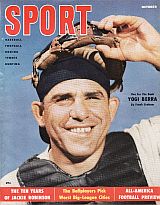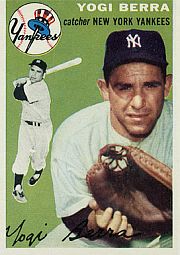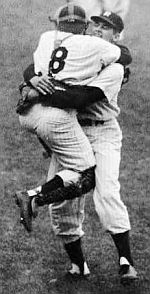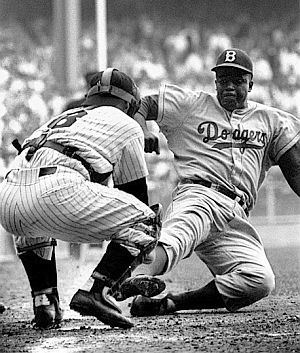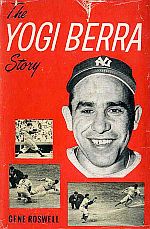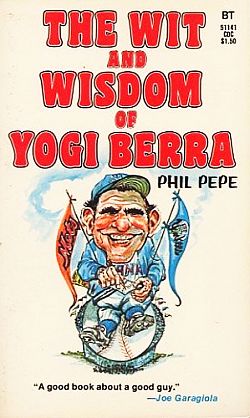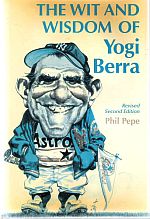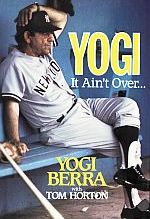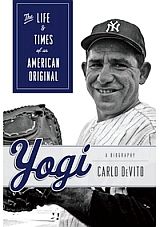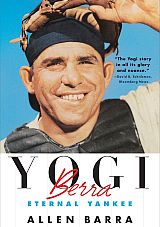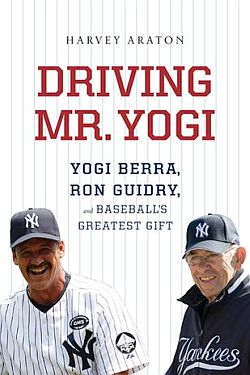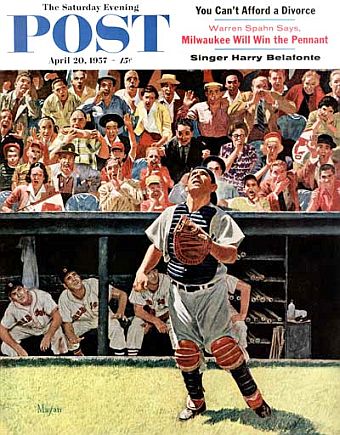
Artist Earl Mayan’s cover illustration of New York Yankee catcher Yogi Berra in action for the April 20, 1957 Saturday Evening Post is based in part on a sketching session Mayan had with Berra. Click for copy.
In 1957, baseball and Yogi Berra were both in prime time, also a golden age for large-format magazines; a time when illustration was still a popular cover art style. In this case, the artist was Earl Mayan, whose rendering features Berra in action, with fans looking on and rival Red Sox players in their dugout also watching.
Mayan, who had separately sketched Berra for the illustration and traveled to Boston for a Yankees-Red Sox game, did other Saturday Evening Post covers in that era, as well as work for other magazines. The Post was then one of the nation’s most widely read weekly magazines, with a circulation then exceeding 2-to-3 million copies per week.
At the time this cover appeared, the 1957 baseball season was just beginning; only a few games had been played. Yogi Berra and the Yankees, in any case, were the sports celebrities of their day. Berra in 1957 was in the prime of his career, having won the Most Valuable Player award in 1954 and 1955. The Yankees had won the previous year’s World Series, besting the Brooklyn Dodgers in 7 games, with Don Larsen in game six of that series pitching an historic perfect game with Yogi Berra behind the plate.

Yogi Berra, New York Yankee, March 1953.
Yet Yogi Berra’s celebrity is now in its eighth decade – something of a record in itself – having served him well in sport, publishing, business and advertising, leaving a distinctive mark both on baseball and the larger culture.
Perhaps most famously, Yogi Berra became known for his comic fracturing of the English language – or what is called “malapropism,” the usually unintentional misuse or distortion of words or phrases, or the wrongful use of similar-sounding words – which in Yogi’s case, led to humorous effect. During his baseball career and after, Berra would become known for a selection of phrases – such as: “It ain’t over till it’s over” and “It’s déj vu all over again,” or, “When you come to the fork in the road, take it.” These “Yogi-isms,” as they came to be called – a few with an element of truth to them – have entered the culture as universally recognized phrases and are widely quoted in a veriety of contexts. In fact, something of a small cottage industry grew up around Yogi’s sayings, as books and advertising helped to make him a “malaprop celebrity” – which would lead to additional advertising opportunities in his later years. Yogi Berra, it turns out, may have the last laugh in all of this – all the way to the bank. More on that part of Berra’s career later; first, the baseball.
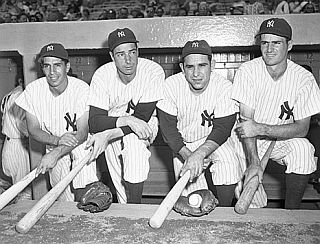
July 1950: Yankee All-Stars, from left: Phil Rizzuto, Joe DiMaggio, Yogi Berra and Gerry Coleman.
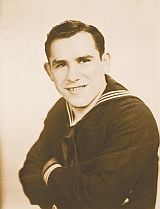 1940s: Yogi Berra in his U.S. Navy uniform during WWII. |
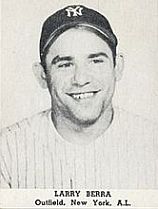 1947 sports card for “Larry” Berra from TipTop Bread. |
With World War II, Berra joined the Navy, serving in North Africa and Europe. He also trained in 38-foot amphibious vehicles armed with rockets and machine guns.
Berra, in fact, was part of the D-Day invasion at Normandy on June 6, 1944. His landing craft went to about 300 yards off shore where they fired rockets into suspected machine gun nests. Berra, then 19, also manned one of the boat’s machine guns. For his heroics during the war, Berra earned a Purple Heart, a Distinguished Unit Citation, two battle stars, and a European Theater of Operations ribbon.
After his discharge, he returned to Yankees’ farm system briefly, during which rival New York Giants manager Mel Ott offered the Yankees $50,000 for Berra’s contract. They declined, and before long, Berra moved up in the Yankees’ farm system and by the fall of 1946 he joined the Yankees’ Major League team.
Once in the majors, Yogi was not regarded as the best defensive man in the business, and was used in various position, mostly in the outfield. Then there was also the matter of his looks, with some New York reporters complaining he didn’t fit the expected Yankee pedigree; he didn’t “look like a Yankee” or wasn’t “photogenic enough.”Berra, in fact, was given all manner of offensive nicknames, most in fun but still hurtful to be sure. One biographer, Carlo DeVito, has written:
“Berra was first tormented by his own team, then later by other teams, and then by the press. … In his first few years he was called ugly, Neanderthal, caveman, gorilla, ape, nature boy, freak, Quasimodo, and many other names. Worse yet, was his own manager calling him ‘the ape.'”
Berra’s rejoinder to the malingers would be that good looks had nothing to do with one’s baseball success. “You don’t hit with your face,” he is known to have said. And on the field and at the plate, Berra soon proved his mettle.
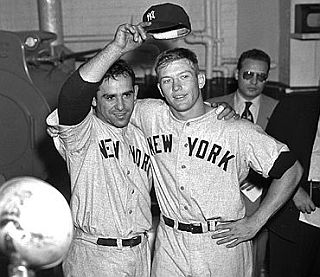
Yogi Berra and Mickey Mantle with reporters following a game in the 1950s.
Between 1949 and 1955, on a team filled with stars such as Mickey Mantle and Joe DiMaggio, it was Yogi Berra who led the Yankees in RBIs for seven consecutive seasons. He was also a 15-time All-Star selection. Berra played his entire 19-year career (1946–1965) with the Yankees as catcher, outfielder, and manager. In 1972, he was elected to the Baseball Hall of Fame.
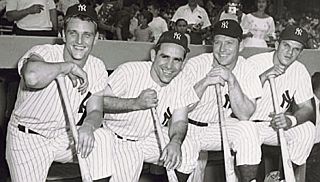
1960 All Stars: From left, Roger Maris, Yogi Berra, Mickey Mantle, and Moose Skowran.
Berra was known as something of a free-swinging hitter, going after balls outside of the strike zone – and sometimes hitting them for homers. “If I can see it, I can hit it,” he would say. Pitchers found him almost impossible to strike out.
Despite being tagged a “wild swinger,” Berra didn’t strike out often. In 1950 he struck out only 12 times in 597 batting appearances. Paul Richards, former player and manager of the Chicago White Sox and Baltimore Orioles during the 1950s and early 1960s, said of Yogi: “He is the toughest man in baseball in the last three innings.”
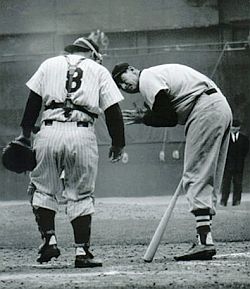
Yogi Bera, No. 8, having a few words with Boston Red Sox great, Ted Williams.
Yogi Berra also became an outstanding catcher, a skill he credits to the coaching of former Yankee great and Hall of Fame catcher, Bill Dickey.
“I was a lousy catcher ’til they got Bill Dickey there [as coach]. Dickey worked me hard. And, I liked it though, what he did for me. I owe everything to Bill Dickey, I really do.”
Behind the plate Berra went on to set his share of records. He led all American League catchers eight times in games caught and in chances accepted, six times in double plays (a major league record), eight times in putouts, three times in assists, and once in fielding percentage. Berra left the game with the AL record for catcher putouts at 8,723, and also another for 148 consecutive games without an error.
Yogi would often talk to the opposing batters in order to distract them. Hank Aaron tells the story about the 1958 World Series, with Yogi behind the plate. Yogi kept telling Aaron to “hit with the label up on the bat.” Finally, Aaron turned and said, “Yogi, I came up here to hit, not to read.”
Among the more famous games that Berra caught, was the only perfect no-hit game in post-season history—catching Don Larsen in Game 5 of the 1956 World Series against the crosstown Brooklyn Dodgers. One of the game’s more iconic photos is Berra leaping into the arms of Don Larsen following the final pitch. In the 1960 World Series, when the underdog Pittsburgh Pirates faced the powerhouse New York Yankees, Berra also was attached to a notable moment in sports history. With all the sports pundits having forecast an easy Yankee victory over Pittsburgh, the Pirates held their own and battled to the very end, as the series was taken to a surprising 7th game.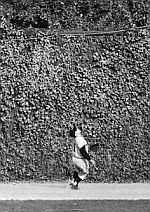
1960: Berra at Forbes Field.
____________________________________________________________
“Jackie Steals Home”
1955 World Series
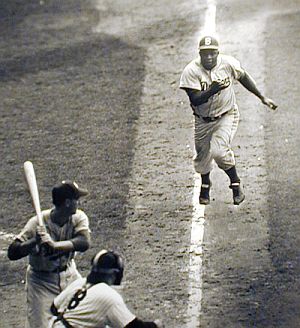 1955 World Series: Jackie Robinson of the Brooklyn Dodgers charges home plate and catcher Yogi Berra. |
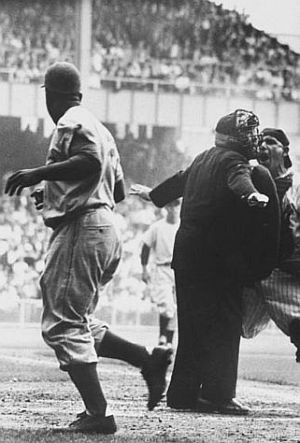 1955: Jackie Robinson “safe,” says the umpire, as Yogi Berra argues the call. Photo, Grey Villet. |
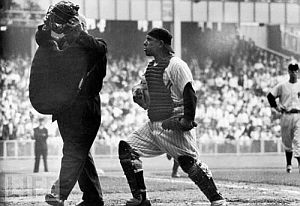 1955: Yogi Berra continues to show his displeasure with Robinson call, pressing his case, but to no avail. |
Perhaps one of the most famous baseball plays with Yogi Berra came when he and Jackie Robinson tangled at home plate in September 1955. It was Game No. 1 of the 1955 World Series with the Yankees facing the Brooklyn Dodgers.
The afternoon game that September 28th was being played at Yankee Stadium in the Bronx before a crowd of some 63,800 fans. Don Newcombe was the starting pitcher for the Dodgers. Newcombe had won 20 games that year. Whitey Ford, with an 18-7 record that year, was pitching for the Yankees.
In the early innings, the game had see-sawed back and forth with each side taking the lead. In the top of the 8th inning, with the Yankees ahead, 6-to-4, Carl Furillo came first to bat. He singled to center field, followed by Gil Hodges who flied out with Furillo remaining at 1st base.
Jackie Robinson came next, and reached base on a ground ball error, sending Furillo to 3rd base and Robinson going to 2nd. Next up was Don Zimmer who hit a sacrifice fly, scoring Furillo and advancing Robinson to 3rd base. There were then two outs.
Jackie Robinson – known for his base running exploits – suddenly takes off from third base as unwary Yankee catcher Yogi Berra was getting set behind the plate with Dodger pinch hitter, Frank Kellert, coming to hit. Robinson by then was barreling down the third-base line heading for home, as Berra by now saw him coming and was preparing for action, waiting for the pitch from Whitey Ford.
As Berra receives the ball from Ford, Robinson goes into his slide in front of home plate. It’s a very close play.
The home plate umpire, Bill Summers, calls Robinson safe, and thereupon, Berra jumps up into the umpire’s face complaining about the call.
Berra continues in a rage, following the umpire, complaining to no avail as Robinson walks off and the score is recorded at 6-to-5. The Dodgers are now within one run of tying the game.
In the end, the Yankees would win the game. They had two homers from Joe Collins and one by rookie Elston Howard. Whitey Ford was the winning pitcher, with relief help in the ninth inning from Bob Grim. For the Dodgers that game, Carl Furillo and Duke Snider had homered.
The Dodgers, however, would win the World Series in Game 7, beating the Yanks, 2-0. For the first time in Series history, an MVP was selected—Johnny Podres, who won Games 3 and 7, pitching two complete games with a shut out in the latter game and posting a series ERA of 1.00. But also long lived in memory from that Series is the controversy over Jackie Robinson’s theft of home.
Several photographers captured the action of the game that day, including Robinson stealing home. Grey Villet captured the scene with a series of photographs, two of which are shown here (#’s 4 & 5). Mark Kauffman, a photographer with Sports Illustrated magazine also captured the scene in the 2nd photo above.
Brad Mangin, a San Francisco freelance sports photographer who specializes in shooting baseball with clients such as Sports Illustrated and Major League Baseball, rates the Kauffman photo – No. 2 in this sequence – as one of the top all-time World Series photos. Adds Mangin of the famous Robinson-Berra controversy:
…I have seen the video replay over and over and it is still hard to see if Jackie was safe or out. The only thing I definitely know about this play is it made a great picture that was captured so beautifully by Mark Kauffman of Sports Illustrated. One thing that makes this image so special to me is the fact that it is one of the first great telephoto pictures made with a long lens from the field level. Until this time most of the baseball pictures shot during the regular season and World Series with long lenses were made from overhead baskets with Big Bertha cameras.
Mangin adds that “the great peak action and expression on Jackie’s face, combined with the unique (for the time) low-to-the-ground angle, make this picture special.”
Yogi Berra, meanwhile, to this day, maintains that Jackie Robinson was “out” at home.
* * * * *
________________________________
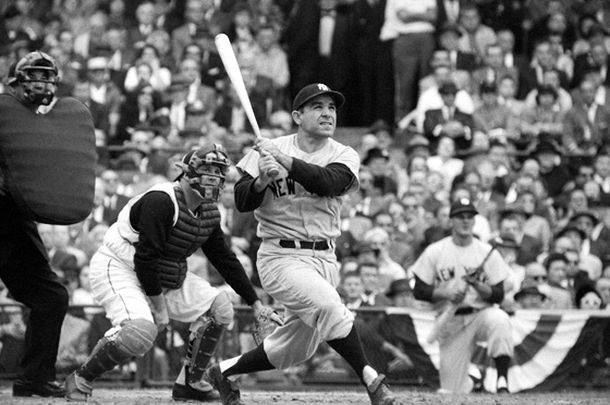
Yogi Berra hitting a 3-run home run for the New York Yankees against the Pittsburgh Pirates at Forbes Field in the 6th inning of Game 7 of the 1960 World Series. Photo: Neil Leifer / Sports Illustrated.
Yogi Berra wasn’t a big guy – about 5′-8″ and 185 lbs in his prime – but he played the game with a fierce tenacity and workman’s diligence that won the respect of his opponents and teammates. He had a long and productive career with the Yankees and gave his all on the field. In June 1962, at the age of 37, Berra showed his endurance by catching an entire 22-inning, seven-hour game against the Detroit Tigers. Berra played on more pennant-winning teams (14), and on more World Series winners (10) than any player in the history of the game. He was elected to the Hall of Fame in 1972, and his New York Yankee jersey, No. 8, was also retired that year.

October 1963: Yogi Berra, beaming at news that he will manage the Yankees.
Berra was hired to manage the Yankees in 1964, and he took them to the World Series, though losing to the Cardinals in seven games. Fired by the Yankees after that World Series, Berra then made a brief return to the field as a player-coach for the New York Mets, playing in just a few games in April-May 1965 before becoming a Mets coach and remaining in that position for the next eight years, including the Mets’ 1969 World Championship season.
In 1972, following the sudden death of Mets manager Gil Hodges, Berra became the Mets manager. Midway through the following 1973 season, the Mets were mired in last place, but still within striking distance.

Yogi Berra as the New York Mets' first base coach, 1969.
Yogi’s Mets went on to defeat the highly favored Cincinnati Reds’ “Big Red Machine” in five games to capture the National League pennant. In the 1973 World Series that followed, Berra’s Mets had a 3-games-to-2 lead on the Oakland Athletics, but lost games 6 and 7. Berra was fired as Mets manager in August 1975.
The next year, he rejoined the Yankees as a coach, remaining in that post as the Yankees won three consecutive American League titles as well as the 1977 and 1978 World Series. He continued as a Yankee coach through 1983, named manager in 1984.
Berra had agreed to stay with the Yankees for 1985 after receiving assurances that he would not be fired, but owner George Steinbrenner fired Berra early in the 1985 season, the message delivered through a third party, creating a rift between the two men. Indeed, for what must have been a painful time for Berra, who loved the Yankee organization and its players, he did not set foot in Yankeedom for 14 years.

Yogi Berra with wife Carmen in Mets attire.
In 1986, Berra joined the Houston Astros as bench coach, remaining there until 1989. Berra is one of only six managers to lead both American and National League teams to the World Series. As a player, coach, or manager, Berra appeared in 21 World Series.
In Berra’s private life, he married his wife, Carmen, in January 1949. They had three children and lived in Montclair, New Jersey during Berra’s playing days. Two of their sons also played professional sports – Dale played shortstop for the Pittsburgh Pirates, New York Yankees, and Houston Astros, and Tim played pro football for the Baltimore Colts.
Yogi Berra’s life off the field, with his business ventures and through his celebrity, is at least as interesting as his baseball life, and that part of the story is next.
Early Advertising
Brand Berra: Pt. 1
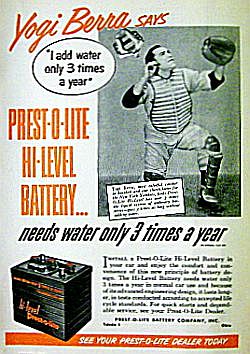
June 1951: Prest-O-Lite ad with Yogi Berra.
Among the first product ads he did was one in the early 1950s for Prest-O-Lite Battery with Berra quoted in as saying, “I Add Water Only 3 Times a Year.” In his earlier product endorsements, Yogi and other Yankees were often given token gifts such as wrist watches for their appearances rather than payments. After Yankee traveling secretary Frank Scott learned in the early 1950s that the players weren’t getting paid for their advertising work, he quit his Yankee job and began representing players for contract payment in their endorsement deals. But Yogi Berra would do o.k. for himself in other endorsement arrangements.
 |
 |
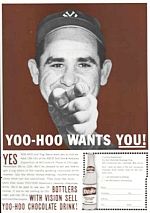 |
 |
In 1955, on a golf course in Haworth, New Jersey, Berra met two members of the Oliveri family whose father, Natale Oliveri, had invented the Yoo-Hoo chocolate drink years earlier. Yogi was soon appearing in print ads for the product. By February 1956, he was made a vice president at the company. Yogi took no compensation for the Yoo-Hoo ads, but was advised to take stock in the company instead, which he did. According to some accounts, Berra also took initiative in suggesting he could do more for the company than merely appear in ads, and helped to bring in other investors. He also convinced a number of his Yankee teammates to endorse and help advertise the product. A series of Yogi Berra Yoo-Hoo ads followed through the 1950s, some that also featured Yogi with Mickey Mantle and/or multiple Yankee teammates. One of the ads at left – “Yoo-Hoo Wants You” – also has Berra pitching to prospective bottlers for the company. He became, in effect, the face of the franchise during the 1950s. The impact of Berra’s and the Yankee involvement with the company was almost instant. Within a few years, You-Hoo became one of the fastest growing soft-drink brands in America. Berra’s contract with the Yoo-Hoo was slated at one point to run for about 15 years. The Yoo-Hoo work, in any case, put him in a someting of new spotlight, with his name sometimes appearing in the New York Times business section. Madison Avenue now knew the name.
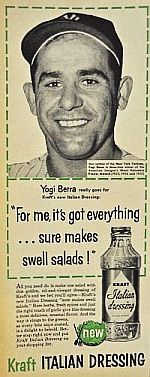
Berra salad dressing ad.
In addition to his involvement with Yoo-Hoo, Berra also did a number of other print and/or TV ads during the 1950s and 1960s for an assortment of sponsors, among them: Kraft Foods, Entenmann’s, Stove Top stuffing, Shelby bicycles, White Rock sparkling beverages, Spencer Chemicals, Spalding baseball equipment, Camel cigarettes, Acme Markets, Ballantine beer and others. In subsequent years, he also did ads for Miller Lite beer, Pepsi-Cola, Jockey underwear and others.
One notable advertising success for Berra came in 1960, after he met George Lois, a rising New York advertising man. Lois was working on advertising for the Quaker Oats Company and its cat food brand, Puss ‘n Boots, and he began developing Berra as a character in the ads. One of these ads shows a cat “working out” at a gym, jumping over a pummel horse and using a trampoline, after which Yogi and the cat having a “conversation” about the cat’s fitness and diet, extolling the virtues of Puss ‘n Boots cat food. The ads became a success and won awards for George Lois who went on to develop other famous TV spots, including “I Want My MTV” ads of the 1980s.
Berra has also mentioned Frank Scott, one of the first sports agents, who helped book Berra in TV commercials and appearances on programs such as The Phil Silvers Show and The Ed Sullivan Show. In any case, by the end of the 1960s or so, Yogi Berra was one of the most successful sports celebrity product endorsers around.
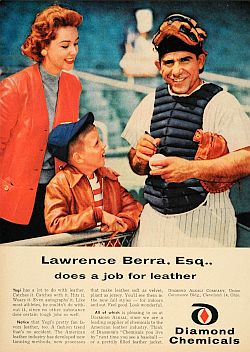
Yogi Berra in a 1957 ad about leather products for the Diamond Chemicals Co.
Yogi has a lot to do with leather. Catches it. Catches with it. Hits it. Wears it. Even autographs it. Like most athletes, he couldn’t do without it, since no other substance does certain tough jobs so well.
Notice that Yogi’s pretty fan favors leather, too. A fashion trend that’s no accident. The American leather industry has developed new tanning methods, new processes that make leather soft as velvet, pliant as jersey. You’ll see them in the new fall style – for indoors and out. Feel good. Look wonderful.
All of which is pleasing to us at Diamond Alkali, since we are a leading supplier of chemicals to the American leather industry. Think of Diamond’s “Chemicals you live by” next time you see a baseball
– or a prettily filled leather jacket.

Yogi Berra in 1964 Ballantine Beer ad.
Publishing
Brand Berra: Pt. 2
 Yogi Berra on the cover of Sport magazine, May 1958. |
 Yogi Berra & Micky Mantle on the cover of Sport, May 1963. |
During his playing years, there had been a number of magazine covers, articles, and sports books about Yogi Berra the ball player. These were nothing special or out of the ordinary – that is, nothing special beyond the normal realm of books about popular sports figures that typically appear during their careers. Among early publications were also a few short, pulp paperbacks such as, Yogi Berra: Baseball Hero (Fawcett, 32pp) by Charles Dexter, and Yogi Berra: The Muscle Man (Barnes, 25pp) by Ben Epstein – both from 1951. Yogi Berra also received front-cover play from major sporting magazines through the late 1950s and early 1960s. Two such covers from Sport magazine, for example, are shown here above – one from May 1958 with Berra at bat, and another from May 1963 with he and Micky Mantle on the cover featuring a story by Mantle – “The Yogi Berra I Know.” There had also been more substantial baseball biographies featuring Berra as well.
In 1952, Joe Trimble did a book on Yogi, titled, Yogi Berra, which appeared in revised editions through the 1960s – a book which grew to 224 pages for the Grosset Sports Library edition of 1965, shown here second from left, published by Grosset & Dunlap.
In 1958, Gene Roswell also wrote a substantial book on Berra, published by Julian Messner in New York, The Yogi Berra Story, which also went into multiple printings through the 1960s. That book is shown here at far left in its 1960 edition.
The New York Times did a story on Berra at an author’s book signing event at a Macy’s department store in New York city. Berra was photographed behind a stack of books with pen in hand. However, when he was asked to write the full name of a person for a gift-book salutation with his autograph, he begged off, saying: “I don’t believe last names should be included in autographs. That makes it too formal… Anyway, I’m a lousy speller.” The book, in any case, went though several printings, helping keep Yogi Berra’s name in some prominence among sports celebrities. He also continued to appear occasionally in sporting magazines. Berra would retire from active play with the Yankees two years later.
“Yogi-isms”
Brand Berra: Pt. 3
By the 1970s, however, a whole new level of Yogi Berra marketing began once his “famous sayings” became part of the mix. And that episode of his life appears to have begun in earnest in 1973-74 with the publication of The Wit and Wisdom of Yogi Berra by author Phil Pepe, published by Belmont Tower paperbacks.
Berra’s rising fame on the notoriety of his “Yogi-isms”– as his humorous phrases and malaprops are sometimes called – appears to have begun, according to some sources, in 1947. In that year, the Yankees had come to play a ball game in Berra’s home town of St. Louis, and on the occasion, the city decided to honor their hometown boy. Nervous about what he would say in the pre-game ceremony, Yogi asked one of his teammates to draft some short opening remarks, which included the line, “I want to thank all the people who made this day possible.” But as Yogi recalls, when he rose to speak at the mike, he stated instead: “I wanna‘ thank everybody here for making this night necessary.” That was the beginning of Yogi’s twisted profundities, as some see it. However, others note that in 1946, as a minor league player, Yogi was admonished about taking wild swings at the plate and was counseled to “think, think think” about what he was doing up there at bat. So he did, and promptly struck out, concluding that one could not “think and hit at the same time” – or words to that effect. In any case, it would be such phrases – and their stories – that began gaining wider and repeated currency in the sporting press and beyond.
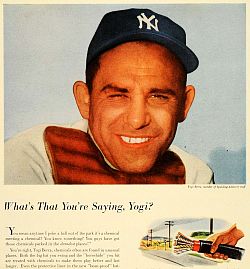
A 1954 Spencer Chemicals magazine ad asks: “What’s That You’re Saying, Yogi?”
Phil Pepe’s The Wit and Wisdom of Yogi Berra, in any case, arrived at an apparently receptive time in the mid-1970s. Pepe’s book, which blended Berra biography with Berra sayings, did well and went into subsequent printings and cover revisions for many years. A 1988 version of that book is shown at near right. The idea of doing books on Yogi Berra wisdom was picked up by other authors as well. And by the late 1980s, Yogi himself got into the act with his own book, this one in 1989 with Tom Horton and McGraw Hill using one of Yogi’s famous sayings as the title – Yogi: It Ain’t Over… This volume appeared first in hardback followed by a 1990 HarperTorch paperback. Yogi-isms also circulated beyond Yogi’s own works, of course, found in various books and magazines. In 1992, for example, Dick Schaap and Mort Gerberg complied Joy in Mudville: The Big Book of Baseball Humor, published by Doubleday, which included a generous selection of Yogi’s phrases.
LTD Enterprises. In 1993, Berra’s three sons, Larry, Tim and Dale, and daughter-in-law Betsy, began thinking they needed a special company to take care of their father’s growing publishing and endorsement deals. Baseball memorabilia was then becoming more of a business opportunity as well. Yogi Berra was then receiving about 100 letters a week in the mail, most seeking his autograph. So Berra’s sons – believing they were just as good if not better suited to protecting and promoting their father’s image than commercial agents – decided to form LTD Enterprises to help manage and market Yogi Berra. They soon created a mail-order business and a Yogi Berra website which now has a Yogi store with baseball memorabilia and links to other sports sites. Berra also continued to have endorsement and advertising deals, including those with Hardee’s food chain and Pringles potato chips, among others. More Yogi books followed as well.
 |
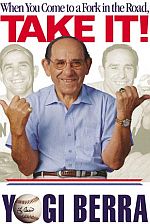 |
 |
 |
In 1997, came The Yogi Book: I Really Didn’t Say Everything I Said!, with Workman Publishing – a volume that would see a number of printings and new editions through the 2000s. By early 1999, The Yogi Book had sold some 300,000 copies and had become a best-seller. Other titles on Yogi-isms – and most with a Yogi Berra by-line – came almost yearly in the 2000s. In 2001, When You Come to a Fork in the Road, Take It!: Inspiration and Wisdom from One of Baseball’s Greatest Heroes, was published, first as Hyperion hardback, followed in 2002 by a paperback. In 2003 came, What Time Is It? You Mean Now?: Advice for Life from the Zennest Master of Them All, published by Simon and Schuster. In 2008, Yogi published with Dave Kaplan, You Can Observe a Lot by Watching: What I’ve Learned About Teamwork From the Yankees and Life with John Wiley & Sons. In 2010, came another edition of The Yogi Book.
In recent years, Yogi Berra sayings have popped up in some surprising places, including business newsletters, magazines, business media, and various websites. A few financial analysts have taken some of Yogi’s sayings an applied them to investing, including one with a short article entitled, “Yogi Berra’s 7 Secrets to Building Wealth.” No word, however, if Yogi has associated with or endorsed these. But even in conversations with his wife, Carmen, Yogi could come up with unexpected quips for sometimes hilarious effect. In one case, for example, Carmen reportedly asked her husband: “Yogi, you are from St. Louis, we live in New Jersey, and you played ball in New York. If you go before I do, where would you like me to have you buried?” – to which Yogi replied: “Surprise me.”
1998-1999
Yogi’s Museum
In their adopted hometown of Montclair, New Jersey, Yogi Berra and family had put down roots since the 1950s. The Berra boys had gone to school there. And Yogi was a regular celebrity in local events and played on the local golf links there as well, establishing an annual golf tournament that has raised well over $1 million to benefit special need boy scouts, educational programs, and scholarships. He also opened a local business there in 1978, with son Tim Berra — the Yogi Berra Racquetball Club. However, by the 1990s a bigger idea grew out of Yogi’s connections with Montclair State University. According to university president, Dr. Irvin D. Reid in remarks to the New York Times: “One evening [in 1996]…eight of us sat down at a restaurant in town, including Yogi and his wife, Carmen. We’d been looking at our athletic needs, long term, and I presented to Yogi the concept of building a stadium in recognition of his contributions to athletics in Montclair… At the time this all went forward, the focus was on Yogi, for no other reason that his relationship with the university had been established. He’s always been our friend, in our golf outing, our fund-raising…”
Yogi Berra Museum & Learning Center, located on Berra Drive in Little Falls, NJ at Montclair State University.
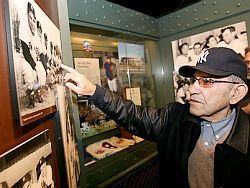
Dec 2009: Yogi Berra pointing out some detail at one of the exhibits at his baseball museum in Little Falls, NJ. Bergen Record photo.
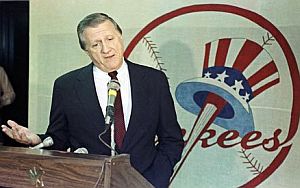
George Steinbrenner, owner of the New York Yankees, making a statement in an undated photo.
|
Old Friends One day in June 1999, Yogi Berra, then 74 years old, went to the Metropolitan Museum of Art in New York to look at baseball cards. The world-renowned museum is also a repository for a collection of more than 300,000 baseball cards dating from 1887. Every six months or so the museum’s American Wing rotates the display of the cards, offering a new theme or subject or period. Berra had come to visit to see the display on one of his former Yankee teammates, Joe DiMaggio, who had died that March. Among the cards displayed were also images of Honus Wagner, Dizzy Dean and Ty Cobb.Yogi Berra had outlived many of his Yankee team- mates. But there were seven of DiMaggio. A New York Times note on Berra’s visit at the museum that day reported, that “Mr. Berra viewed the DiMaggio cards reverently…”. In the museum display, there was also one card of Berra arrayed with three of his other 1953 teammates: Billy Martin, Phil Rizzuto and Mickey Mantle. Yogi Berra had outlived many of his Yankee teammates, and his remembrances on seeing old baseball cards like these were no doubt tinged with sadness of his departed friends. Billy Martin died at age 61 in December 1989; Mickey Mantle died at the age of 63 in August 1995; and Joe DiMaggio died at age 84 in March 1999. Phil Rizzuto, also a former business partner to Berra in their early years, would die some years later in August 2007 at age 89. Another former teammate, Elston Howard (MVP 1963), who was the first black player on the Yankees and would replace Berra at catcher, died at age 51 in 1980. Some years later, in February 2005, when Yogi was 79 years old, he came to speak at an exhibit honoring Elston Howard at Westchester County during Black History Month, where Yogi, accompanied by his wife Carmen, became emotional over his old teammate. Berra had written an introduction to a 2001 book on Howard by his wife Arlene Howard titled, Elston and Me: The Story of the First Black Yankee. |
PBS Documentary. In August 1999, a PBS-TV documentary on Berra’s career, Yogi Berra: Deja Vu All Over Again, was hosted by sportscaster Bob Costas. During the show, Costas and Berra visited Berra’s childhood neighborhood in St. Louis. Former baseball greats Ted Williams and Jackie Robinson both appeared in segments of the film praising Berra for his “clutch” hitting.One of Yogi’s boyhood friends in the film said that Yogi hadn’t changed and “never went uptown.” Jeffrey Peisch, the PBS producer-director, observed that during the making of the film he was “really touched seeing Yogi with guys he grew up with.” He noted that Yogi’s old friends “still called him Lawdie [a nick name from Berra’s mother who could not pronounce Larry]. One told me that Lawdie hadn’t changed; that Lawdie never went uptown.” Meanwhile, back in the New York city region a few years later, following the unsettling weeks after the 9/11 terrorist attack in 2001, Berra appeared in one of a series of New York TV ads meant to lure tourists back to Manhattan. In the spot, after conducting the New York Philharmonic in Ravel’s La Valse, Berra turns to the camera in deadpan saying, “Who in the heck is this guy Phil Harmonic?” Berra also continued to be in demand for commercial TV advertising.
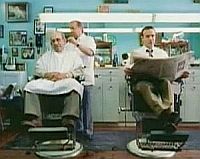 |
 |
The AFLAC Ad
In late May 2002, during ESPN’s Sunday Night Baseball game with the New York Yankees and the Boston Red Sox, the AFLAC insurance company debuted a new TV commercial titled “Berra at the Barber.” The 30- second spot began with Yogi Berra in the barber’s chair getting a haircut while another man waits his turn. “Not too close,” Yogi says, as the barber clips a bit too close to his ear.
“Whatta ya’ think I got that insurance?,” Yogi says to the barber. “What insurance is that, Yogi?” asks the waiting customer in the next chair as the AFLAC Duck waddles into the scene, making his trademark AFLAC sqawk. Yogi then proceeds to answer the question, explaining the insurance plan with a series of Yogi-isms: “The one ya’ really need to have if you don’t have it. That’s why you need it.”
Cut to waiting customer asking “Need what?,” as the duck chimes in again with his “AFLAC” phrase while Yogi explains: “Well, if you get hurt and miss work, it won’t hurt to miss work.” Cut to puzzled customer and befuddled duck. “And they give ya’ cash,” adds Yogi, “which is just as good as money.” Cut again to puzzled barber, puzzled customer, and frustrated duck, leaving the shop.
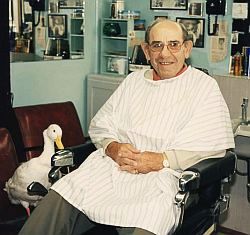
Yogi Berra, between takes, with his co-star.
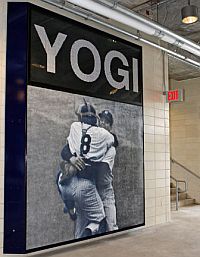
Yogi’s image at new Yankee stadium.
Elsewhere, however, the Berra legend and image continued to be lauded, especially in Yankee land. At the July 2008 All-Star Game at Yankee Stadium, Berra had the honor of being the last of the 49 Hall of Famers in attendance to be announced. The hometown favorite received the loudest standing ovation of the group. During 2008, Berra also appeared at the closing ceremonies for the old Yankee Stadium and the New York Mets’ Shea Stadium. And in the new stadiums that emerged in their place for each team, Yogi Berra’s image appeared in displays.
At the Mets’ new home at Citi Field Stadium, Berra appears in a photograph on a video board reaching to tag Jackie Robinson as he stole home in the 1955 World Series. At the new Yankee stadium too, Berra appears in a large wall-size version of the iconic photo of he and Don Larsen embracing at the famous 1956 World Series perfect game. He is also on view in the new Yankee Stadium museum, in statue form, catching a pitch from Larsen.
During the 2000s, there were also more books about, or written by, Yogi Berra. In 2003, with Dave Kaplan, Berra published Ten Rings: My Championship Seasons. In 2004 came, Yogi Berra’s Favorite Baseball Radio Shows, by Mike Stewart and Mike Kennedy. And in 2006 under Yogi’s name came Let’s Go, Yankees!
In the latter half of the decade, two more biographies appeared – one in 2008 by Carlo DeVito, titled, Yogi: The Life and Times of an American Original, published in hardcover by Triumph Books, and another in March 2009 by Allen Barra titled, Yogi Berra: Eternal Yankee. But wait, there’s still more.
2010
The iXP Deal

2010: Yogi Berra, a trusted sports legend, called upon to help to sell public safety & security services for the iXP Corporation.
The ads feature photos of Berra accompanied by one or more of his Yogi-isms which fit a theme being touted in the particular ad. Some of the sayings have been quoted for many years, while others have been written for the campaign. The idea the campaign sought to convey generally was that iXP was a consistent, reliable and trustworthy performer — just as Hall-of-Famer Yogi Berra was, with decades of baseball achievement under his belt. The campaign was crafted by Stimulus Brand Communications of Ewing, N.J. There was also a separate PR effort by Ink Media of New York to promote the ad campaign. As of May 2010, the ads had appeared on billboards, at airports, and on the iXP website. Additional print advertising and possible TV spots were also in the offing.
William E. Metro, president and chief operating officer at iXP in Cranbury, N.J. explained to New York Times writer, Stuart Elliott, that many of his company’s potential clients were in law enforcement, and so they couldn’t pick just any celebrity. They needed someone who was “squeaky clean” and someone their clients could relate to. Law enforcement officials, mayors, city managers and fire chiefs, Metro explained , were experienced individuals and often middle-aged.Madison Avenue puts Yogi Berra in a special category of sports star endorsers – trusted and established older stars who are less risky than younger super- stars. Older, former professional athletes are a known quantity to them. And with someone like Berra, who evokes the feelings of the good old days, that was an added plus. Madison Avenue types, in fact, put Yogi Berra in a special category of sports-star endorsers – in league with baseball’s Cal Ripken Jr., football’s Joe Montana, or golfers like Jack Nicklaus and Arnold Palmer – trusted and established older stars who are less risky than younger superstars capable of unexpected scandal or controversy, as occurred a few years ago with Tiger Woods. Although Berra might be expensive, using him in the iXP campaign was also a way “to get immediate name recognition,”said Metro. In making their choice iXP “immediately gravitated to Yogi’s character: he’s humble, he’s self-effacing and he was a team leader; as catcher, he controlled the game,” said Metro. iXP, as a personal-services organization, needed to build a level of trust and confidence with their clients, Metro explained – “to get them to put their riskiest operations into our hands,” he said. “They have to know we’re serious from the beginning.”
And as part of the iXP campaign, they would also integrate Berra’s famous sayings into the ads. Many of the Yogi-isms fit messages that iXP wanted to get out, Metro explained. One example was Berra’s, “the future ain’t what it used to be” – which fit a changing approach to public safety because of new terrorism threats. “A nickel ain’t worth a dime anymore,” works for iXP as well, said Metro, since municipal governments are trying to supply emergency response with less public money. And finally, stating the obvious in Yogi-ese: “If it’s an emergency, it’s usually urgent.”
Driving Mr. Yogi
In 2012 came a somewhat different Yogi book; one that told a more human story of Yogi in his continuing baseball world as he moved into his eighties. That book’s title is, Driving Mr. Yogi: Yogi Berra, Ron Guidry and Baseball’s Greatest Gift. Witten by Harvey Araton, a sports writer for the New York Times, Driving Mr. Yogi tells the story of the long-running friendship between Berra and Guidry, and how Guidry became an unofficial helper and chauffeur to Berra during their visits to the Yankee’s spring training camp in Florida over a decade or so that began in the year 2000.Berra and Guidry had first met at Yankee spring training in 1976 when Guidry was 25, and Berra 51, then returning as Billy Martin’s bench coach. Guidry was an up-and-coming southpaw trying to build a future for himself. It happened the two men had adjacent lockers in the Yankee clubhouse, and Guidry began seeking’s Berra’s advice about how to approach hitters, and from there something of a friendship began. Guidry would play his entire career with the Yankees, helping them with the World Series in 1977 and 1978. He won the Cy Young Award in 1978, compiling a 25-3 record that year with a 1.74 ERA. Guidry and Berra saw each other only sporadically during Berra’s self–imposed, 14-year exile from the organization through 1999. But when Yogi returned with his spring training visits in 2000, his former old-timer mates were no longer around, but he and Guidry began eating meals together and their friendship began anew.
The common bond between the two was baseball, but Araton’s story also covers the foibles and demands of an aging sports figure, and is therefore an account of growing old in America, too. As Araton explains, the book is also “an examination of a man who refuses to surrender to human frailty.” Berra in this book is still the well-known Yankee celebrity, of course, but he is also, as Araton explains, “an Everyman, much like our grandfathers and grandmothers and parents, who clings to his identity however he can because it makes him feel not only happy, but vital and alive.” Guidry, the attentive friend and helper, sees the moody, demanding, and cantankerous side of Berra along the way, but is also an enabler of purpose and dignity for the aging Berra.

Spring training, 2011: Ron Guidry left, Yogi Berra, right. Photo, Barton Silverman/New York Times.
… During exhibition games, [Berra and Guidry] sit on the bench together, in the corner by the water cooler, studying the game. “Every once in a while, Yogi will see something about a guy and think that he can help,” Guidry said.
Last season [2010], Berra noticed that pitchers were getting Nick Swisher out with breaking balls and mentioned to Guidry that he thought Swisher might try moving up in the batter’s box to attack the pitch sooner.
“Tell him, not me,” Guidry said.
“Nah, I don’t want to bother him,” Berra said.
After Swisher grounded out, he walked past Guidry and Berra in the dugout. Guidry stood up, pointed at Berra. “He wants to talk to you,” Guidry said. Swisher sat down, heard Berra out and doubled off the wall in his next at-bat. After he scored, he returned to the dugout and parked himself alongside Berra.
“For Yogi, that meant everything,” Guidry said. “Now who knows if that had anything to do with the great season Swisher had? But in Yogi’s mind, he made a friend and he felt, ‘O.K., that justifies me being here,’ even though everybody loves having him here anyway.
“But that’s the thing — for Yogi, spring training is his last hold on baseball,” Guidry added. “When he walks through that door in the clubhouse, sits at the locker, puts on his uniform, talks to everybody, jokes around, watches batting practice, goes back in, has something to eat, and then he and I will go on the bench and watch the game, believe me, I know how much he really looks forward to it.”
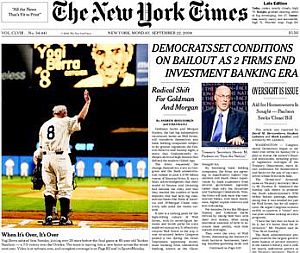
Sept 22, 2008: During turbulent time, the New York Times put Yogi Berra on the front page, waving to the crowd during “last game” ceremonies at Yankee Stadium.
For additional baseball stories at this website please visit “Baseball Stories: 1900s-2000s,” or go to the Sports directory page for more stories in that category. Thanks for visiting — and if you like what you find here, please make a donation to help support the research and writing at this website. Thank you. – Jack Doyle
Note: Yogi’s wife, Carmen, passed away in early March 2014. They had recently celebrated their 65th wedding anniversary. She was 85. A new photo of she and Yogi appears midway below in “Sources, Links & Additional Information”. Yogi died not long thereafter, on September 22, 2015. He died in his sleep of natural causes at age 90. During major league play at that time, the Yankees added a number “8” patch to their uniforms in honor of Berra, and at a number of games – including those of the Yankees, Dodgers, Astros, Mets, Nationals, Tigers, Pirates, and his hometown St. Louis Cardinals – a moment of silence was held. In New York, the Empire State Building was lit with vertical blue and white Yankee “pinstripes” and the city lowered all flags to half-staff in tribute.
|
Please Support Thank You |
____________________________________
Date Posted: 21 October 2012
Last Update: 8 February 2023
Comments to: jdoyle@pophistorydig.com
Article Citation:
Jack Doyle, “The Yogi Chronicles: 1940s-2012”
PopHistoryDig.com, October 21, 2012.
____________________________________
Sources, Links & Additional Information
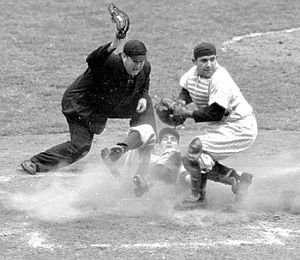 Oct 6, 1950: Yogi Berra making tag at the plate on Philadelphia Phillies’ Granny Hamner in 9th inning, Game 1, 1950 World Series. AP photo. |
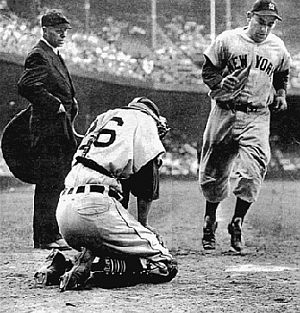 1951: Yogi Berra rounding the bases to home plate after what appears to have been a home run. |
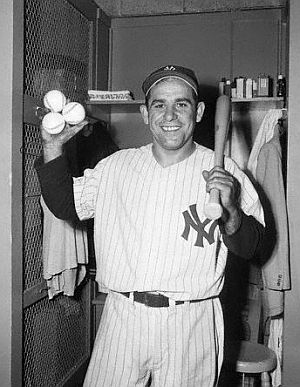 May 1955: Yogi Berra holding three baseballs and bat in clubhouse. |
 1957 Topps baseball card in collector’s case depicting “Yankees' Power Hitters” Mickey Mantle / Yogi Berra, with authenticated autographs. Robert Edwards Auctions reports this card sold for twelve hundred dollars in 2005. |
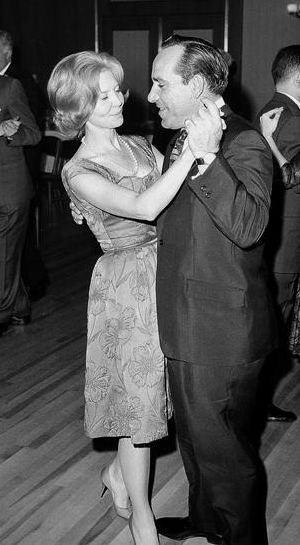 Dec 1963: NY Yankees then-manager, Yogi Berra, dances with wife Carmen at the annual Baseball Writers' dinner in NY City. (AP photo). |
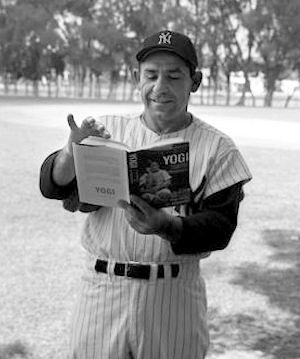 Yogi Berra reading from his 1961 autobiography at Yankee spring training camp. Tony Kubek photo for Life. |
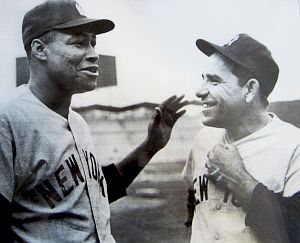 Elston Howard and Yogi Berra photo from a Bronx Museum exhibit titled "Baseball in the Bronx." |
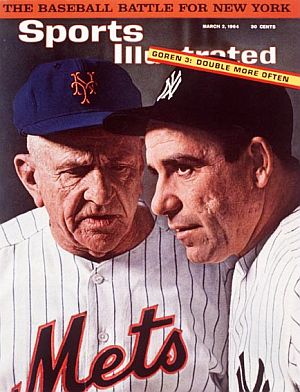 March 1964: NY Yankee manager Yogi Berra, and NY Mets manager Casey Stengel, on the cover of Sports Illustrated in “battle for New York” feature story. |
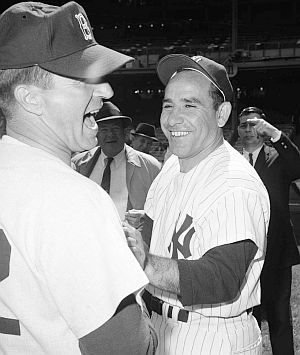 April 16, 1964: New York Yankee manager Yogi Berra, and Boston Red Sox manager Johnny Pesky, have a few laughs before season-opening game in New York. AP photo/John Lindsay. |
 March 2004: Derek Jeter and Yogi Berra during a pre-game warm-up session for Yankess and Devil Rays game in Tokyo, Japan. |
Ed Fitzgerald, “The Fabulous Yogi Berra,” Sport, August 1951.
James P. Dawson, “Happy Yanks Heap Praise on Stengel, Mantle, Woodling, Berra and Martin; Victory Sets off Explosion of Joy..,” New York Times, October 8, 1952, Sports, p. 38.
“Berra Solid Man of Bomber Crew; Yogi Quiet and Shy, But His Bat Is Noisy,”New York Times, Thursday, October 11, 1956.
William J. Briordy, “Berra’s Four Hits Pace 10-4 Verdict; Yanks Get 16 Blows as Ford Goes Route Against A’s for His 6th…,” New York Times, Wednesday, July 31, 1957.
Yogi Berra, Official Website.
Yogi Berra Profile — Academy of Achieve- ment.
Yogi Berra, “My Boyhood Idol,” Parade Magazine (with photos of Berra and Joe Medwick), March 20, 1960.
Louis Effrat, “Author Berra Signs Yankees’ Pact; Once Bashful Yogi at Work Writing Autobiography; His 16th Contract With Club Calls for Pay Rise,” New York Times, January 13, 1961, p. 18.
“Yanks’ Homer Derby Goes West And Berra Ponders a New Pitch; Yogi Asks: What Happens if One Star Hits 61 in 154 Games but the Other Finishes With More in 162?,” New York Times, August 22, 1961.
Yogi Berra with Til Ferdenzi, Behind the Plate, Argonaut Books, 1962.
UPI, “Yogi Doesn’t Draw Laughs,” Kingsport Times (Tenn.) January 24, 1963, p.15, and (same story),”No One Has Laughed at Yogi Berra In A Long Time,” Lodi News Sentinel (Calif), Thursday, February 21, 1963, p. 15.
Robert Lipsyte, “The Man and the Myth; A View That Berra Is a Bit of Each: A Lovable Myth and a Sensitive Man,” New York Times, October 25, 1963, Sports, p. 20.
“Baseball: The Myth Becomes a Manager,” Time, Friday, November 1, 1963.
Joe Trimble, Yogi Berra (hardback), New York: Grosset & Dunlap, 1965, With forward by Casey Stengel Yogi Berra (Author),
Phil Pepe, The Wit and Wisdom of Yogi Berra, Hawthorn, June 1974, 183pp.
Phil Linz, Book Review: “Yogi And the Harmonica; The Wit and Wisdom of Yogi Berra By Phil Pepe,” New York Times, June 9, 1974, Sports, p.2.
Joseph Durso, “Yogi and the Snipers,” New York Times, August 12, 1975, p. 23.
Paul Wilner, “Yogi Berra: At Bat In Montclair,” New York Times, New Jersey Weekly, January 8, 1978.
Ira Berkow, “Players; Some Words From Berra,” New York Times, Tuesday, December 6, 1983.
George Vecsey, “Yogi’s Back in Style,” New York Times, December 17, 1983, p. 19.
Murray Chass, “All Jokes Aside, Berra Is Back on Top” New York Times, February 13, 1984.
Yogi Berra with Tom Horton, Yogi: It Ain’t Over, McGraw-Hill, 1989.
Steve Jacobsen, “For Yogi Berra, It Still Ain’t Over, And That’s Refreshing,” Los Angeles Times April 2, 1989.
Richard Sandomir, “For Yoo-Hoo and Yogi, It’s Deja Vu All Over Again,” New York Times, April 20, 1993.
“The Wisdom of Casey Stengel…and Yogi Berra,” Geoffrey C. Ward and Ken Burns, Baseball: An Illustrated History, New York: Alfred A. Knopf, 1994, p. 314.
Yogi Berra, The Yogi Book: I Really Didn’t Say Everything I Said!, Workman Publishing, 1997.
Harvey Araton, “There’s Room for More Than One Local Hero,” New York Times, April 27, 1997.
Harvey Araton, “Sports of The Times; On the Other Side of the River, Another Hailing of Champions,” New York Times, October 25, 1998.
Harvey Araton, “Yogi and the Boss Complete Makeup Game,” New York Times, January 6, 1999, p. 1.
Yogi Berra, The Yogi Book (hardback), Workman Publishing Co., March 1999, 128pp.
Patricia Winters Lauro, The Media Business: Advertising; “One of Baseball’s Most Colorful Figures Finds He Is in Demand Again,” New York Times, April 30, 1999.
Yogi Berra with Howard Liss and Bob Powell, Yogi Berra’s Baseball Book: The Game and How to Play It, Lion Books, June 1999.
Charles Strum with Amy Waldman, “Public Lives: Baseball Greats Shine in New Fields,” New York Times, June 23, 1999
Dulcie Leimbach, “Jerseyana; In the Galleries, Baseball Hits a Homer, New York Times, August 8, 1999.
Carolyn Olson, “Yogi Berra Comes Home: The Making of a PBS Documentary About the Hall of Fame Catcher Brought Him to His Childhood Home on the Hill,” Everyday Magazine, St Louis Post-Dispatch, August 10, 1999.
“Where’s Yogi? Everywhere, It Seems,” The Sporting News, October 25, 1999, p. 68.
AFLAC, “Yogi Berra Teams Up With AFLAC in Newest Commercial,” PRNewsWire.com, May 22, 2002.
“Yogi Pitches Fresh Malaprops in AFLAC Campaign,”Brandweek, May 27, 2002.
Yogi Berra with Dave Kaplan, What Time Is It? You Mean Now?: Advice for Life from the Zennest Master of Them All, Simon & Schuster, 2002.
Yogi Berra, When You Come to a Fork in the Road, Take It!: Inspiration and Wisdom from One of Baseball’s Greatest Heroes, Hyperion, 2002
Yogi Berra with Dave Kaplan, Ten Rings: My Championship Seasons, New York: Harper Collins, 2003.
Marek Fuchs, “Yogi Gets 100% Emotional, and Then Some, for a Pal,” New York Times, February 19, 2005.
Dave Anderson, Sports of The Times; “Berra, 80, a Folk Hero and a Philosopher, Has Observed a Lot by Watching,” New York Times, May 12, 2005.
Yogi Berra Interview, Baseball Hall of Fame, June 1, 2005, New York, NY.
Christopher Hann, Yogi Berra, Dave Kaplan, “It Ain’t Over,” New Jersey Monthly, February 1, 2008.
Carlo DeVito, Yogi: The Life and Times of an American Original, Triumph Books (hardcover), 2008.
Pete Hausler, “The Man Behind the Malaprop,” Wall Street Journal, April 29, 2008.
Carlo DeVito, Book Excerpt, ” ‘Yogi: The Life and Times of an American Original’,” Wall Street Journal, April 29, 2008.
Yogi Berra, You Can Observe a Lot by Watching: What I’ve Learned About Teamwork From the Yankees and Life, John Wiley & Sons, 2008.
“Number of Days Until Spring Training: Yogi Berra (#8),” Fack Youk, Thursday, February 5, 2009.
Steven V. Roberts, “Book Review: ‘Yogi Berra: Eternal Yankee’ by Allen Barra,” Washington Post, Sunday, March 22, 2009.
King Kaufman, “The Genius of Yogi Berra,” Salon.com, Wednesday, March 25, 2009. Biographer Allen Barra talks about his new book, in which the lovable, quotable old catcher comes off as intelligent, shrewd and decent.
“Jackie Robinson Steals Home” (0:38),” YouTube.com, Uploaded April 2, 2009.
Glenn Altschuler, Book Review, “‘Yogi Berra: Eternal Yankee’ by Allen Barra,”Pittsburgh Post-Gazette, April 12, 2009.
Joe Lapointe,”Berra, At 83: A One-of-a-Kind Common Man,” New York Times, April 16, 2009
Larry Dorman, “Berra Calls ’em as He Sees ’em,” New York Times, January 19, 2010.
Stuart Elliott, Campaign Spotlight, “For Berra, It Ain’t Over Till … Well, You Know the Rest,” New York Times, May 24, 2010.
“iXP Corporation Launches National Advertising Campaign,”Reuters.com, May 25, 2010.
Yogi Berra, The Yogi Book (paperback), Workman Publishing Co., May 28, 2010, expanded edition, 175 pp.
“Two Area Firms Land Yogi Berra Account – US1 Home,” PrincetonInfo.com, 2010.
“55 Years Ago: Jackie Robinson Steals Home Base – Game One, The 1955 World Series,” Monroe Gallery, Friday, September 24, 2010.
Brad Mangin, “The 10 Greatest World Series Photos of All Time,” PhotoShelter.com, October 26, 2010.
“Yogi Berra,” Wikiquote.org.
Harvey Araton, “For Berra and Guidry, It Happens Every Spring,” New York Times, February 23, 2011.
Ben Shpigel, “When Yogi Berra Speaks, Yankees’ Cervelli Listens,” New York Times, Saturday February 26, 2011.
WFAN/AP, “Joe Torre, Bob Costas Help Yogi Berra Reopen His Montclair, NJ Museum,” CBS New York, June 24, 2011.
“Berra, Teixeira to Be Honored at Thurman Munson Awards Dinner,” Bombers Beat.mlblogs.com, January 31, 2012.
Harvey Araton, Driving Mr. Yogi: Yogi Berra, Ron Guidry and Baseball’s Greatest Gift, Houghton Mifflin Harcourt, 2012.
“Harvey Araton on Driving Mr. Yogi,” Amazon.com.
Barbara Chai, Media & Marketing: “With Ad Push, Publisher Is Aiming for a Home Run on Yogi Berra Book,” Wall Street Journal, March 25, 2012.
David Mielach, TMN, “Yogi Berra on Baseball and Business,” CNBC.com, Wednesday, 4 April 4, 2012.
“Yogi Berra Signed Ballantine Beer Ad in Frame-1964,” NYTStore.com, 2012.
“Yogi, The Legendary ‘Say What’ Kid,” PSACard.com, 2012.
“Yogi Berra, Baseball Great” (with Harvey Araton, Ron Guidry and Yogi Berra), The Charlie Rose Show, May 10, 2012.
Zach Berman, “Yankee Stadium Welcomes Berra for His 87th Birthday,” New York Times, May 12, 2012.
“Don Larsen, Yogi Berra Reunite On 56th Anniversary Of World Series Perfect Game,” CBS New York, October 8, 2012.
The Yogi Berra Museum & Learning Center, Yogi Berra Drive, Little Falls, NJ.
_____________________________

